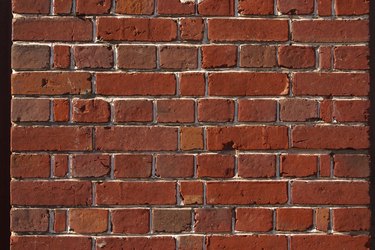
Cracks in the mortar of your brick wall may occur for several reasons. Normal movement of the foundation or expansion and shrinkage of materials within the wall can leave cracks, or there might be a more serious issue that poses structural concerns. If you notice horizontal cracks in your brick wall, contact a professional to inspect the wall. Don't leave the crack to develop into a major problem.
Stud Backing
Video of the Day
In terms of mortar cracks, one smaller than 1/16-inch thick is considered a hairline crack. Although the term hairline implies that it is a minor issue, hairline cracks can still allow water to penetrate the brick, which can lead to larger cracks. Horizontal hairline cracks in the mortar between bricks are caused by a few different things. Brick veneers use a metal stud backing, and these studs are flexible. The movement of stuck backings can cause horizontal cracks in the mortar midway up the wall or in an area where significant stress is placed on the brick. If this is the cause, the crack would run along the horizontal bed joint. Using a stiff backing wall can prevent these cracks from occurring.
Video of the Day
Normal Movement
Vertical and horizontal cracks may occur in brick structures due to normal movement of the building's foundation. These occur typically due to the use of different materials in the same wall. Some mortar materials may shrink while the bricks naturally expand, which results in small cracks. When cracks appear in the mortar of brick walls due to foundation settlement, they usually occur vertically. In these cases, the cracks aren't cause for concern. However, most settlement is short-term, so cracks continuously appearing or enlarging indicate a larger problem. Cracks smaller than 1/4 inch are not usually caused by ongoing settlement issues. If the cracks begin to shear off and run horizontally or in a stair-step pattern, you may have a structural concern no matter how small the cracks. Get your wall and foundation inspected to determine if repairs are necessary.
Wall Tie Failure
Brick walls built after the 19th century typically contain two sections of brick that run parallel to each other with about 2 inches of space between. To hold these walls together, metal wall ties are installed. These ties may be made of wrought iron or steel without any rust resistance because galvanized ties didn't become the norm until much later. In houses built before World War II, wrought iron or unprotected steel ties are more common, and these corrode rapidly. Horizontal cracking that increases in size at the top of the structure and bulging brickwork are signs of wall tie failure, which should be inspected to determine if repairs are possible. Corroded wall ties can affect the stability of the walls, so if they are repairable, stainless steel wall ties should replace the corroded ties.
Repairing Minor Cracks
Hairline and settlement cracks that are not a structural concern can be repointed. This process involves raking out the mortar to twice the original size of the joint and packing the cavity with new mortar. Because repointing can be noticeable if the mortar can't be matched, face grouting is another option for repairing minor horizontal cracks. In this process, fine textured grout is spread over the surface of the joints to seal the cracks. Face grouting isn't often used because the brick face has to be protected, which can be difficult.